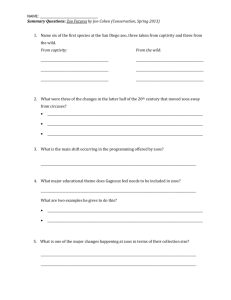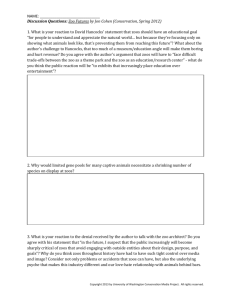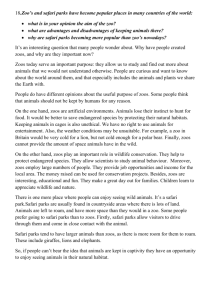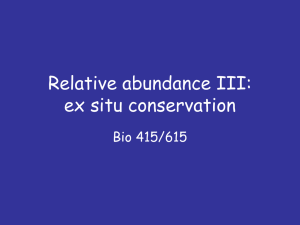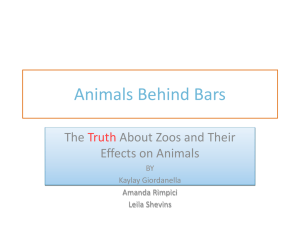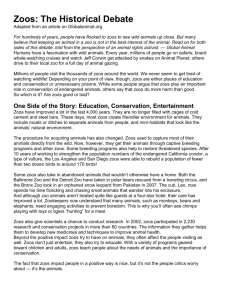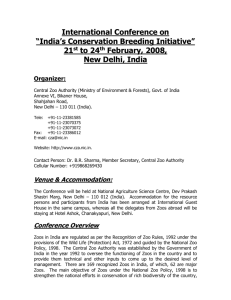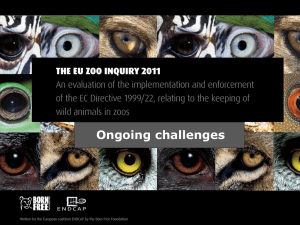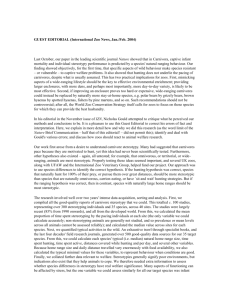The Role of Zoos in Wildlife Conservation
advertisement
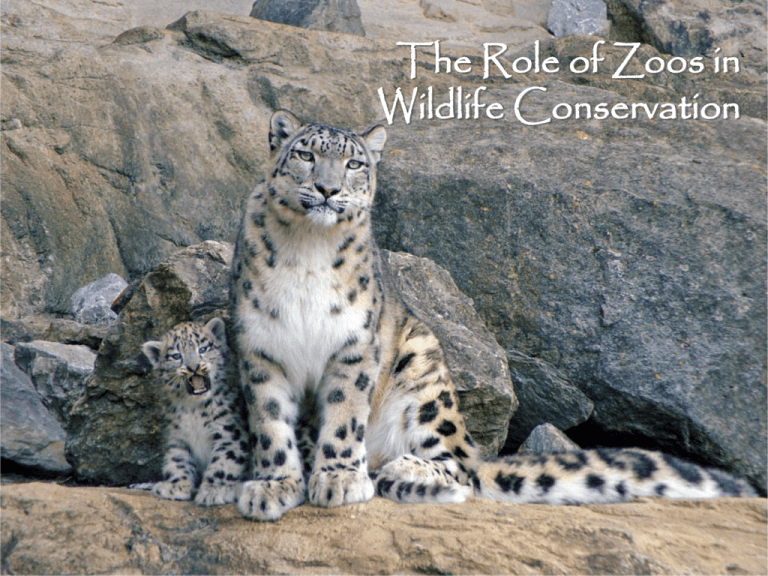
The Role of Zoos in Wildlife Conservation An estimated 600 million people will visit a zoo within the next year. That’s 1 out of every 10 people on the planet. What’s the attraction? • Entertainment • Education • Biophilia- “love of life or living systems” • Reminders that we’re not the only ones who live on this planet. • • To understand the role of Zoos, we have to understand about our history with animals. • For the majority of our time as humans, that relationship has been about two things: Domestication • • • • • • Dogs (from wolves) - 15-35,000 years ago Sheep -11-13,000 years ago Goats -12,000 years ago Cows -10,000 years ago Chickens - 4,500 years ago Elephants - 4,500 years ago http://en.wikipedia.org/wiki/Domestic_animals First known zoo-type collections • Eygpt, ~2,500 BC Some pharaohs maintained huge numbers of animals (Ramses II had giraffes, lions, ostrich) • Syria, 1,500 BC King Thutmose III kept monkeys, leopards, birds, giraffe • Babylonia, 600 BC King Nebuchadnezzar collected lions • King Solomon collected animals from Africa and Asia (as well as women- 700 wives and 300 concubines) • China- ~400 BC- “Garden of Intelligence” 1500 acre menagerie Aristotle • 4th century BC, extensive Greek menageries allow Aristotle to conduct the first systematic zoological survey• “The History of Animals” described 300 vertebrate species …and then there was Rome • Rome – With the expansion of the Holy Roman Empire, conquerors radiated out of the Mediterranean into Africa, the Middles East, Asia, Europe – Brought in animals by the thousands – Unfortunately, they were also good at record keeping – Single day’s slaughter might include >100 bears, >400 leopards, >500 lions (to put 500 lions in perspective, that would wipe out the entire population of lions living in Asia) Tower of London “Martha” September 1, 1914 Role of the Modern Zoo • Recreation • Education • Conservation • Research 1970’s 1990’s 1980’s • Through the 1970’s, zoos probably had a negative effect on wildlife populations • Many of the animals were still taken from the wild. • Few efforts were in place to put animals back. Ex-Situ Contributions • Research – Captive breeding – Veterinary care • Opportunity to work directly with animals that are otherwise inaccessible • Contributes to research methods for animals in the wild – Husbandry & Caretaking • Diet – Behavioral Research • Behavioral enrichment Species Survival Plan (SSP) • Established in 1981 to provide guidance for captive breeding of endangered species to maintain genetically diverse and healthy populations of animals in zoos. • Think of it as a fancy computer dating service for animals. • Zoo’s “ Bread & Butter” Sumatran Rhino Ex-Situ Conservation • Captive breeding – Artificial insemination – Embryo transfers – Frozen embryo transfers – Interspecies embryo transfers – Cloning • Seed bank • “Emergency room methods” – $$$ Artificial Insemination (AI) Artificial Insemination (AI) Frozen Zoos CryoBioBank Zoos as conservation centers • 1970’s- increasing ecological awareness • Zoos once again find that many of the animals they have in their collections are disappearing in (or have disappeared from) the wild. • And a new conservation status category is created: “Extinct in the Wild” IUCN Red Data List Extinct in the Wild Extinct in the Wild Micronesian Kingfisher Guam Rail Pere David’s Deer Bali Mynah Mohr’s gazelle Arabian oryx Waldrapp Ibis • thought to have been extinct in the wild • other population found based on conversations with Bedouin traders only exist in captivity Captive breeding not limited to zoos • Specialized breeding facilities that are closed to the public • Many specialized avian and felid breeding facilities Clouded leopards Mauritius kestrel Lonesome George- last surviving Pinta Island Tortoise Reintroduction efforts • Long stated goal of zoo breeding programs • Not implemented quite as much - why? California Condor Peregrine Falcon Black-footed Ferret Red Wolf Golden Lion Tamarin Vast improvements in exhibit design and animal care accompanied by increased reproductive success A Window on the Wild… • Partnership between the Cincinnati Zoo (later other zoos) and the World Wildlife Fund in-situ (Lat.) “in the natural state, in the wild” • Zoos supporting conservation efforts or partnerships in the wild • Usually focused on species found on zoo’s grounds • Provide vital support and, in turn, receive updates from the field, lectures, recognition as partner in helping with species’ conservation In-Situ Conservation -Cincinnati Zoo Conservation Fund- Many zoos now supporting conservation in the wild • Bronx Zoo- Wildlife Conservation Society • Disney’s Animal Kingdom • Woodland Park Zoo (here in Seattle!) • London Zoological Society • Columbus Zoo AZA • Association of Zoos and Aquariums http://www.aza.org • Accreditation organization • Oversees and manages SSP ZACC • Zoos & Aquariums Committing to Conservation • Group that was formed to accelerate zoos’ focus on both ex-situ and in-situ conservation efforts • Meetings mix of zoo folk looking to get involved in the field, and wildlife biologists seeking partnerships and funding • Great win-win relationship Zoo Careers • • • • • • • • • • • • • • • Keeper/Animal Caretaker Aquarists Commissary/dietician Veterinarian/Vet Techs Horticulturalist/Gardener Behavioral enrichment specialist Reproductive technician Accounting Marketing/Publicity/Media Relations Food Service Gift Shops/Vendors Grant writers Business Operations Writers Seasonal • • • • • • • • • • • • • • • • Animal trainers Development Security Maintenance Plumbers Electricians Artists Exhibit designers Photographer/videographer Educators Distance Learning Technicians Special Events First Aid IT Litter Administration/Directors Suggested Readings • The Crowded Ark by Jon Luoma • Zoos in the 21st Century: Catalysts for Conservation? (Cambridge University Press) • Hope for the Animals and Their World by Jane Goodall and Thane Maynard
